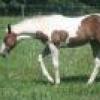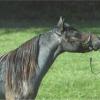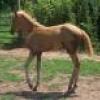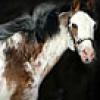A good horse color book?
Forums
Re: A good horse color book?
You can definitely learn a lot from everyone here. I have Dr. Sponenburg's book and yes, it is behind in some areas but I also think it is very good. I got it many years ago before I did much online. It helped me to learn the basics and I still go to it from time to time.
Re: A good horse color book?
Sponenberg is about to release his new edition, so if you can wait a while, that would be more up-to-date.
Don't get Jeanette Gower's book...I think it's terrible. Great pictures, though...she just presents a lot of her "theories" about how various colors are caused (with no scientific backing) and then acts like because she's been breeding a long time she knows more than the people who've done research in the field for years. A lot of it is just made up.
Greene's book is interesting, but I don't think it's really what you're looking for.
Re: A good horse color book?
Beat me to it.....JG's book is good for the pictures, and read it if you know a bit about colour....mine is so full of corrections and post-it notes I have run out of space, but it got me thinking.
Never buy a book on colour and accept what it says, not even the Sponenberg one, they are all outdated by the time they are printed, and a lot of the stuff they print is purely conjecture or opinion, anyway.
We have a couple of people on here who are now actively involved in colour identification and DNA, and they do keep us up to date, but even then it is good to dispute if you do not agree.
If someone is sure of their facts, and the facts are correct, they will never mind discussing it...I began to "smell a rat" when I read the bit in JG's book where she states she now [i]charges[/i]to answer letters!!!!
Talk about arrogant, and you never see her on any of the colour boards discussing anything either, far too grand!
I wish someone would "out" the book for the well written rubbish that is mostly is.
But stick around, we will always help if we can.
Just don't call anything "tovero" :-w
No, really, please don't!! x_x
Re: A good horse color book?
First off welcome to the site, we love :newbie
Jane, you must be getting soft in your old age - you forgot the: "don't call anything 'overo'" tag to go with the "to" word.... :rofl
Gander, the reason we say that those terms do nothing to inhance the genetic color identification. "Overo" is actually any one, any combo or all of the following: splash, sabino and/or frame (LWO); "Tovero" is tobiano with splash, sabino and/or frame (any one, two or all combined with the tobi :roll: ). It is frustration to those of us who make an effort to be correct (and Rabbitsfizz will call you on it everytime :whip - :laugh1 )
Re: A good horse color book?
[quote="critterkeeper"]"Overo" is actually any one, any combo or all of the following: splash, sabino and/or frame (LWO); "Tovero" is tobiano with splash, sabino and/or frame (any one, two or all combined with the tobi :roll: ). [/quote]
Now, that IS frightening, ha ha.... See, when I grew up, we called such horses "pintos" with either overo or tobiano coloring. I can't remember any other terms, even sabino, from back in those years. Of course, I'm used to hearing "sabino" nowadays.
People nowadays seem to call a spotted horse a "paint" much more often than a "pinto" (it seems the word "pinto" is sort of disappearing, at least among people I talk with). So I just went to Wikipedia. Wikipedia claims that, in order for a horse to be a Paint, it must be registered in the APHA and be an offspring of registered Quarter Horse, American Paint Horse, or Thoroughbred bloodlines. Correct? If so, I'd guess a majority (maybe slight majority) of pinto-looking horses out in roadside fields are still pintos but not Paints.
I'm looking for beautiful and unusually-colored horses around the US for a photo project I've been working on. I'd like to be able to identify the horses correctly - and I'd LOVE to understand (as much as possible) what I'm seeing. The first colorful Thoroughbred I ever saw, a 'white' colt named Clarence Stewart, absolutely left me smitten with his unusual coloring...and I've never gotten over it. At the time, though, I had no idea what might have caused his white coat.
Thanks so much for your book thoughts, everyone - which are very helpful. I'll ask questions here before looking for other sources. :)
And, uh, rabbitsfizz, so....it's subtle.....but what you're telling me is you don't particularly care for...."tovero"? ;)
Re: A good horse color book?
OK, these are [i]patterns[/i]we are talking about, BTW, not "colours".
Tobiano, Splash, Frame and Sabino are patterns, and they are all completly different, genetically.
The "overo" patterns have no DNA simialrity to one another.
So each pattern is distinct, and should be treated as such.
Re: A good horse color book?
"Pinto" is the generic description for all the white spotting patterns. "Paint" refers to horses registered with the APHA. Therefore, all Paints are "pinto" in their patterns. But not all pintos are "Paints" because they are not all registered with the APHA. Because the major defining characteristic of Paint horses is their pinto coloring, many people now refer to any pinto as a "Paint" which is not technically correct.
Re: A good horse color book?
I [i]think[/i] I understand the rudimentary difference between patterns vs. colors. But I think a spotted TB was recently registered in the Weatherbys Stud Book as "coloured," so the terminology I've learned sometimes gets in the way. When I say I'm interested in "colorful" horses, for instance, I mean horses of either particular colors or unusual patterns.
I'm under the assumption (yes/no?) that champagne, perlino, palomino, bay, black, etc., are considered "colors."
Spotted creations, like Appaloosa, tobiano (a particular pinto pattern), pinto, and such, are patterns - although they might have a 'base color' (genetic code) featuring any number of colors (bay, chestnut, etc.). Years ago, we also used the terms skewbald and piebald to represent horses of various patterns.
For decades I've been immersed in Thoroughbred terminology, and the powers-that-be don't use terms like sorrel or dun or buckskin - or, until 2003 or so, palomino. They use "roan," however, at every turn...so even that's been a frustrating learning process.
I understand the Paint vs. pinto thing (although I didn't know what particular breeds were at play till Wikipedia ;) ). It's just interesting to me that, nowadays, people generally call spotted horses "Paint" automatically no matter what their breed/heritage. Perhaps it's because it sounds more interesting than "pinto."
Thanks again.
Re: A good horse color book?
[quote="Gander"]I'm under the assumption (yes/no?) that champagne, perlino, palomino, bay, black, etc., are considered "colors." [/quote]
Correct---champagne, perlino, etc., are modifiers of the two basic colours a horse can be--black and not black (red).
[quote="Gander"]
Spotted creations, like Appaloosa, tobiano (a particular pinto pattern), pinto, and such, are patterns - although they might have a 'base color' (genetic code) featuring any number of colors (bay, chestnut, etc.). Years ago, we also used the terms skewbald and piebald to represent horses of various patterns. [/quote]
Skewbald/piebald were used to define horses of "broken colour", i.e., pinto patterning. Most of the usage that I'm familiar with, of those terms, are of English/UK origin, but I've never found anything that states that it was meant for any horse of white + base colour or specifically just pinto-patterned horses. The closest would probably be Merriweather Lewis in his description of seeing "pied" horses in the Nez Perce tribal herds, but even there he falls down, since photographic evidence after the war of 1877 between the NPs and the US Cavalry indicate that the tribal herds included appaloosa, pinto and unpatterned horses. General O.O. Howard's diary makes mention of the colour of exactly ONE horse--a red roan...highly descriptive, NOT! LOL
So, one can infer that either the NPs had very few appaloosa-patterned horses that it wasn't worth commenting, or that the appaloosa patterning was so common in the East that it wasn't necessary for either gentleman to comment further. /sigh/ :BH
Diane
Re: A good horse color book?
[quote="NZ Appaloosas"] The closest would probably be Merriweather Lewis in his description of seeing "pied" horses in the Nez Perce tribal herds, but even there he falls down, since photographic evidence after the war of 1877 between the NPs and the US Cavalry indicate that the tribal herds included appaloosa, pinto and unpatterned horses. General O.O. Howard's diary makes mention of the colour of exactly ONE horse--a red roan...highly descriptive, NOT! LOL
So, one can infer that either the NPs had very few appaloosa-patterned horses that it wasn't worth commenting, or that the appaloosa patterning was so common in the East that it wasn't necessary for either gentleman to comment further. /sigh/ :BH
[/quote]
That's SO interesting!...and it's hard to believe Appaloosas were either of those. Heck, even if Mr. Lewis or Gen. Howard saw them all the time, you'd think such horses would be worth mentioning with their most unusual patterning.
It's also really interesting that there's photographic evidence of the aftermath of the 1877 war. I'm guessing a photo(s) shows war casualties, and you can see various patterns on the fallen horses? Or perhaps portraits taken afterward of Native Americans with their mounts...
Thanks so much for your reply! (and, yes, that "red roan" thing sure paints an uncertain picture, doesn't it) ;)
Re: A good horse color book?
Oh gosh, that pinto v. paint thing would drive me absolutly bonkers in Alabama. Someone would be talking about their "paint" colt and it would take a while to figure out it was actually a spotted saddle horse then OTHER people would call their APHA horses "spotted". :hammer
At least here (oklahoma) Paint means APHA.
Re: A good horse color book?
Welcome Gander...we don't bite on here so please just ask away !....well that is except Rabbitsfizz but she means well ;)
Things change all the time which is excellent as learning is SO much fun....a lot of us on here have been in Equine colour now for some years and we still love to see new pictures and learn about new discoveries in the field so just remember we love questions and pictures.
Enjoy !!!!!!!!!!!!!! :flower









Re: A good horse color book?
Honestly? If you just want to learn the basics, do it online. We can help you out.
No matter which book you get, they will all be behind the latest developments. Just poke around on here, and ask questions. The basics are easy and you'll see plenty of examples.
If you want to get more technical, are interested in the nuts and bolts of it all, or just want an in-depth resource onhand, then I would go for Sponenberg.
What would you like to know?